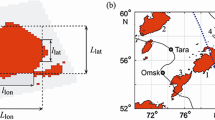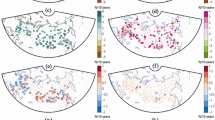Abstract
Due to the fact that the recent decades have become the warmest in the history of meteorological observations for the territory of Northern Eurasia, it is relevant to assess the long-term variability of the convective potential of the atmosphere in changing climate. The spatiotemporal dynamics of the characteristics of atmospheric instability and the frequency of occurrence of convective hazards such as thunderstorm and hail in Western Siberia are analyzed. The northward displacement of the boundaries of active convection estimated by the temperature and humidity parameters of the atmosphere has been registered in the recent decade. The duration of the thunderstorm season and the number of days with a thunderstorm per year increased, as well as the number of days with durable hail and large hail. The height of cumulonimbus clouds generated by vast thunderstorm cells is determined.



Similar content being viewed by others
REFERENCES
L. G. Ananova, V. P. Gorbatenko, and I. A. Lukovskaya, “Radar Characteristics of Convective Clouds during Squalls in the Southeastern Part of Western Siberia,” Meteorol. Gidrol., No. 7 (2007) [Russ. Meteorol. Hydrol., No. 7,32 (2007)].
O. N. Bulygina, V. M. Veselov, T. M. Aleksandrova, and N. N. Korshunova,Description of the Dataset of Atmospheric Events at the Russian Weather Stations. The State Registration Certificate No. 2015620081, http://meteo.ru/data/345-atmosfernye-yavleniya-sroki#описание-массива-данных.
The Second Roshydromet Assessment Report on Climate Change and Its Consequences in the Russian Federation (Roshydromet, Moscow, 2014) [in Russian].
V. P. Gorbatenko and T. V. Ershova, Lightning as a Link of Global Electric Circuit (TGPU, Tomsk, 2011) [in Russian].
V. P. Gorbatenko and D. A. Konstantinova, “Convection in the Atmosphere over the Southeast of Western Siberia,” Optika Atmosfery i Okeana, No. 1, 22 (2009) [in Russian].
V. P. Gorbatenko, S. Yu. Krechetova, M. Yu. Belikova, and O. E. Nechepurenko, “The Comparison of Atmospheric Instability Indices Retrieved from the Data of Radio Sounding and MODIS Spectroradiometer on Thunderstorm Days over Western Siberia,” Meteorol. Gidrol., No. 5 (2015) [Russ. Meteorol. Hydrol., No. 5, 40 (2015)].
V. P. Gorbatenko, O. E. Nechepurenko, S. Yu. Krechetova, and M. Yu. Belikova “Verification of Atmospheric Instability Parameters Retrived from MODIS/Terra Spectroradiometer Information Using Radiosonde Data,” Optika Atmosfery i Okeana, No. 7, 29 (2016) [in Russian].
E. P. Gordov, V. Yu. Bogomolov, E. Yu. Genina, and T. M. Shul’gina, “Analysis of Regional Climatic Processes in Siberia: An Approach, Data and Some Results,” Vestnik NGU, Ser.: Informatsionnye Tekhnologii, No. 1, 9 (2011) [in Russian].
A. V. Eliseev, A. N. Ploskov, A. V. Chernokulsky, and I. I. Mokhov, “A Correlation between Lightning Flash Frequencies and the Statistical Characteristics of Convective Activity in the Atmosphere,” Dokl. Akad. Nauk, No. 1,485 (2019) [Dokl. Earth Sci., No. 1, 485 (2019)].
M. V. Kurgansky, A. V. Chernokulsky, and I. I. Mokhov, “The Tornado over Khanty-Mansiysk: An Exception or a Symptom?”, Meteorol. Gidrol., No. 8 (2013) [Russ. Meteorol. Hydrol., No. 8, 38 (2013)].
Yu. P. Mikhailovskii, A. A. Sin’kevich, S. D. Pawar, V. Gopalakrishnan, Yu. A. Dovgalyuk, N. E. Veremei, E. V. Bogdanov, A. B. Kurov, A. Kh. Adzhiev, A. M. Malkarova, and A. M. Abshaev, “Investigations of the Development of Thunderstorm with Hail. Part 2. Analysis of Methods for the Forecast and Diagnosis of the Electrical Properties of Clouds,” Meteorol. Gidrol., No. 6 (2017) [Russ. Meteorol. Hydrol., No. 6,42 (2017)].
Siberian Center of Planeta Research Center for Space Hydrometeorology, http://www.rcpod.ru.
Scientific-applied Reference Book on the USSR Climate, Ser. 3: Long-term Data, Parts 1–6, Issue 20: The Tomsk, Novosibirsk, Kemerovo Oblasts and the Altai Krai (Gidrometeoizdat, Leningrad, 1993) [in Russian].
O. E. Nechepurenko, V. P. Gorbatenko, D. A. Konstantinova, and V. V. Sevastyanov, “Instability Indices and Their Optimum Thresholds for the Forecast of Thunderstorms over Siberia,” Hydrometeorologicheskie Issledovaniya i Prognozy, No. 368 (2018) [in Russian].
V. S. Platonov and E. V. Novikova, “Assessing the Quality of Simulation of Extreme Meteorological Characteristics in the Kara Sea Region by Modern Reanalyses,” in Proceedings of the Conference Dedicated to the 100th Anniversary of the Birth of M. A. Petrosyants “M. A. Petrosyants and Russian Meteorology” (Tireks, Moscow, 2019) [in Russian].
Manual on Synoptic Meteorology, Ed. by A. S. Zverev (Gidrometeoizdat, Leningrad, 1972) [in Russian].
A. A. Sin’kevich,Convective Clouds in Northwestern Russia (Gidrometeoizdat, Leningrad, 2001) [in Russian].
Strategic Resources and Conditions for Sustainable Development of the Russian Federation and Its Regions. Short Summary of Implementation of the Program of Fundamental Research of the Division for Earth Sciences of Russian Academy of Sciences No. 13 in 2012–2014 (Institute of Geography of RAS, Moscow, 2014) [in Russian].
Yu. P. Sumin, “Experience on Forest Fire Control (Localization) by Cloud Seeding,” Trudy GGO, No. 262 (1971) [in Russian].
A. V. Chernokulsky, F. A. Kozlov, O. G. Zolina, O. N. Bulygina, and V. A. Semenov, “Climatology of Precipitation of Different Genesis in Northern Eurasia,” Meteorol. Gidrol., No. 7 (2018) [Russ. Meteorol. Hydrol., No. 7, 43 (2018)].
A. V. Chernokulsky, M. V. Kurgansky, and I. I. Mokhov, “Analysis of Changes in Tornadogenesis Conditions over Northern Eurasia Based on a Simple Index of Atmospheric Convective Instability,” Dokl. Akad. Nauk, No. 6,477 (2017) [Dokl. Earth Sci., No. 2, 477 (2017)].
S. M. Shmeter,The Physics of Convective Clouds (Gidrometeoizdat, Leningrad, 1972) [in Russian].
M. T. Abshaev, A. M. Abshaev, and A. M. Malkarova, “Estimation of Antihail Projects Efficiency Considering the Tendency of Hail Climatology Change,” inProceedings of the 10th WMO Scientific Conference on Weather Modification (World Meteorological Organization, 2012).
M. T. Allen, “The Characteristics of United States Hail Reports. 1955–2014,” Electron. J. Severe Storms Meteorol., No. 3, 10 (2014).
Copernicus Climate Change Service. ERA5 Hourly Data on Single Levels from 1979 to Present, https://cds.climate.copernicus.eu/cdsapp#!/dataset/reanalysis-era5-single-levels?tab=overview.
A. A. Kostornaya, E. I. Saprykin, M. G. Zakhvatov, and Y. V. Tokareva, “A Method of Cloud Detection from Satellite Data,” Russ. Meteorol. Hydrol., No. 12,42 (2017).
A. A. Sinkevich, Yu. P. Mikhailovskii, Yu. A. Dovgalyuk, N. E. Veremei, E. V. Bogdanov, A. Kh. Adzhiev, A. M. Malkarova, and A. M. Abshaev, “Investigations of the Development of Thunderstorm with Hail. Part 1. Cloud Development and Formation of Electric Discharges,” Russ. Meteorol. Hydrol., No. 9,41 (2016).
H. Takahashi and Z. Luo, “Where Is the Level of Neutral Buoyancy for Deep Convection?”, Geophys. Res. Lett., 39 (2012).
University of Wyoming. Department of Atmospheric Science, http://weather.uwyo.edu/upperair/sounding.html.
E. V. Volkova and A. B. Uspenskii, “Detection of Clouds and Identification of Their Parameters from the Satellite Data in the Daytime,” Russ. Meteorol. Hydrol., No. 12, 32 (2007).
Funding
The research was supported by the Russian Foundation for Basic Research (grant 18-45-700010 r_а).
Author information
Authors and Affiliations
Corresponding author
Additional information
Russian Text ©The Author(s), 2020, published in Meteorologiya i Gidrologiya, 2020, No. 5, pp. 108-117.
About this article
Cite this article
Gorbatenko, V.P., Kuzhevskaya, I.V., Pustovalov, K.N. et al. Assessment of Atmospheric Convective Potential Variability in Western Siberia in Changing Climate. Russ. Meteorol. Hydrol. 45, 360–367 (2020). https://doi.org/10.3103/S1068373920050076
Received:
Revised:
Accepted:
Published:
Issue Date:
DOI: https://doi.org/10.3103/S1068373920050076




